|
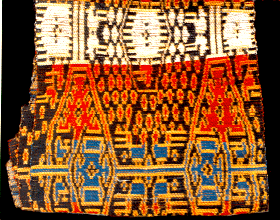 It is a brocade of the Dai Nationality. The local people call it "sal cloth." As the historical document records, they made muslin early in the Han Dynasty. It subcategorizes into cotton and silk brocades. The weaving of cotton brocade is initiated by incessant weft while the weaving of silk brocade is initiated by intermittent weft. The cotton brocade takes the yarn of original colour as its material; the silk brocade is woven by the weft dyed in red or black. The Dai brocade in Dehong is dyed in the blending of red, black, emerald green and green. Its patterns are lion, tiger, peacock, tree and figure, etc. It is a brocade of the Dai Nationality. The local people call it "sal cloth." As the historical document records, they made muslin early in the Han Dynasty. It subcategorizes into cotton and silk brocades. The weaving of cotton brocade is initiated by incessant weft while the weaving of silk brocade is initiated by intermittent weft. The cotton brocade takes the yarn of original colour as its material; the silk brocade is woven by the weft dyed in red or black. The Dai brocade in Dehong is dyed in the blending of red, black, emerald green and green. Its patterns are lion, tiger, peacock, tree and figure, etc.
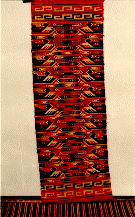 It is a brocade of the Tujia Nationality. The General History of the Ming Dynasty calls it "striped cloth." In the Song Dynasty they called it "brook cloth" and "brook-cave facing." Tujia brocade is made by waist weaver. It takes yarn as warp and silk as weft. The weaving method is "interweaving the intermittent warp and incessant weft." It is a brocade of the Tujia Nationality. The General History of the Ming Dynasty calls it "striped cloth." In the Song Dynasty they called it "brook cloth" and "brook-cave facing." Tujia brocade is made by waist weaver. It takes yarn as warp and silk as weft. The weaving method is "interweaving the intermittent warp and incessant weft."
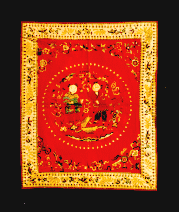 It is a traditional handicraft of China. Along the Chinese history, it has been once called "zao", "needle embroidery", "patterned embroidery" and is generally called "embroidering patterns." For it is made by women, it is also called "woman"s needlework." As recorded in the Book of Shan, the garments donned by ancient kings and emperors are manually embroidered. Since the Han Dynasty the embroidering skill has been greatly improved with a large variety of embroidery methods. The calligraphy and drawing can be embroidered since the Tang and Song Dynasties. The embroidery is widely employed in making clothing, tobacco bag, extra pocket, perfume bag, pillowship cushion, hat, shoes, screen and tapestry, etc. The embroidery is also applied to making cloth portraits of gods and spirits, the curtain for Buddha sculptures in temples and the stage costumes. The traditional skills of embroidery include sparse needling, manual needling, side needling and many other innovative skills. Many embroidering skills with local characteristics have come into being. It is a traditional handicraft of China. Along the Chinese history, it has been once called "zao", "needle embroidery", "patterned embroidery" and is generally called "embroidering patterns." For it is made by women, it is also called "woman"s needlework." As recorded in the Book of Shan, the garments donned by ancient kings and emperors are manually embroidered. Since the Han Dynasty the embroidering skill has been greatly improved with a large variety of embroidery methods. The calligraphy and drawing can be embroidered since the Tang and Song Dynasties. The embroidery is widely employed in making clothing, tobacco bag, extra pocket, perfume bag, pillowship cushion, hat, shoes, screen and tapestry, etc. The embroidery is also applied to making cloth portraits of gods and spirits, the curtain for Buddha sculptures in temples and the stage costumes. The traditional skills of embroidery include sparse needling, manual needling, side needling and many other innovative skills. Many embroidering skills with local characteristics have come into being.
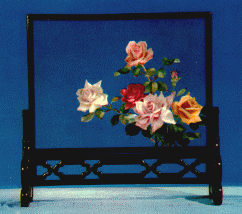 It is one of the most famous Chinese embroideries. It is the general name for the embroidered products in Suzhou, Jiangsu Province. There emerged many embroidery workshops and embroidery markets in the Song Dynasty. Up to Ming and Qing Dynasties its embroidery flourished for a time. Su embroidery is famous for its elaborateness and elegance. It used to be made by the unmarried daughters of noble families, and so it is also called "boudoir embroidery. " Its characteristics include elegant colours, fine needling, the application of halo dyeing, and the vacant lines left between colours. Its needling skills include looping needling, even needling, net embroidering, etc. Later they created double-faced embroidery, which is used to embroider screen, palace fan, handkerchief, scarf and window lattice. Its pattern themes vary from "the celebration of harvest", "wealthy family", "dragon and phoenix symbolic of propitiousness", "well-being through hundreds of years" to "abundance in grains and happiness in life", "richness in fruits", "happy encounter", and "twin lotus flowers." The embroidered pictures have "the Hunting Picture", "the Scroll of Plum and Crane", "the Scroll of Osmanthus Under the Moon" as their themes. There are many other embroidered products, such as dress and adornments, beddings and ornaments attached to the waist. It is one of the most famous Chinese embroideries. It is the general name for the embroidered products in Suzhou, Jiangsu Province. There emerged many embroidery workshops and embroidery markets in the Song Dynasty. Up to Ming and Qing Dynasties its embroidery flourished for a time. Su embroidery is famous for its elaborateness and elegance. It used to be made by the unmarried daughters of noble families, and so it is also called "boudoir embroidery. " Its characteristics include elegant colours, fine needling, the application of halo dyeing, and the vacant lines left between colours. Its needling skills include looping needling, even needling, net embroidering, etc. Later they created double-faced embroidery, which is used to embroider screen, palace fan, handkerchief, scarf and window lattice. Its pattern themes vary from "the celebration of harvest", "wealthy family", "dragon and phoenix symbolic of propitiousness", "well-being through hundreds of years" to "abundance in grains and happiness in life", "richness in fruits", "happy encounter", and "twin lotus flowers." The embroidered pictures have "the Hunting Picture", "the Scroll of Plum and Crane", "the Scroll of Osmanthus Under the Moon" as their themes. There are many other embroidered products, such as dress and adornments, beddings and ornaments attached to the waist.
|
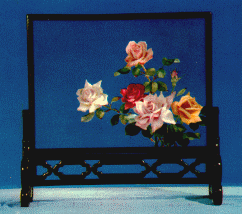 |
重点阅读
[错误报告] [推荐] [收藏] [打印] [关闭] [返回顶部]

 已有
已有













